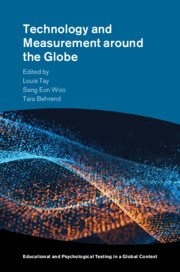Book contents
- Technology and Measurement around the Globe
- Educational and Psychological Testing in a Global Context
- Technology and Measurement around the Globe
- Copyright page
- Contents
- Contributors
- Introduction
- Part I Foundations
- Chapter 1 Machine Learning Algorithms and Measurement
- Chapter 2 Toward Improved Workplace Measurement with Passive Sensing Technologies
- Chapter 3 Information Privacy
- Part II Global Perspectives on Key Methods/Topics
- Part III Regional Focus
- Index
- References
Chapter 1 - Machine Learning Algorithms and Measurement
from Part I - Foundations
Published online by Cambridge University Press: 08 November 2023
- Technology and Measurement around the Globe
- Educational and Psychological Testing in a Global Context
- Technology and Measurement around the Globe
- Copyright page
- Contents
- Contributors
- Introduction
- Part I Foundations
- Chapter 1 Machine Learning Algorithms and Measurement
- Chapter 2 Toward Improved Workplace Measurement with Passive Sensing Technologies
- Chapter 3 Information Privacy
- Part II Global Perspectives on Key Methods/Topics
- Part III Regional Focus
- Index
- References
Summary
This chapter provides an overview of the common machine learning algorithms used in psychological measurement (to measure human attributes). They include algorithms used to measure personality from interview videos; job satisfaction from open-ended text responses; and group-level emotions from social media posts and internet search trends. These algorithms enable effective and scalable measures of human psychology and behavior, driving technological advancements in measurement. The chapter consists of three parts. We first discuss machine learning and its unique contribution to measurement. We then provide an overview of the common machine learning algorithms used in measurement and their example applications. Finally, we provide recommendations and resources for using machine learning algorithms in measurement.
Keywords
Information
- Type
- Chapter
- Information
- Technology and Measurement around the Globe , pp. 11 - 45Publisher: Cambridge University PressPrint publication year: 2023
